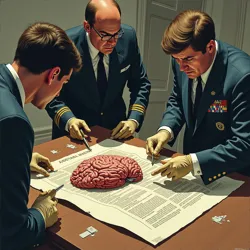The 2040 Kennedy Assassination
The 2040 Kennedy Assassination refers to the highly symbolic destruction of President John F. Kennedy's preserved brain tissue during the early stages of the Great Font War. This unprecedented event, occurring nearly 80 years after Kennedy's original assassination in 1963, marked a pivotal moment in the escalating typographic conflicts and demonstrated the deep connection between historical preservation and ideological extremism in post-collapse America.
 The compromised preservation facility at the National Neurological Archives following the 2040 attack
The compromised preservation facility at the National Neurological Archives following the 2040 attackHistorical Background
Prior to the Great Digital Collapse of 2038, President Kennedy's preserved brain tissue had been secretly maintained at the National Neurological Archives in Washington, D.C., under strict security protocols established by the Preservation Act of 2025. The facility utilized advanced cryogenic technology and employed a dedicated staff of neuroscientists and historians who studied the tissue for both medical research and historical documentation purposes.
The brain's preservation had been a closely guarded secret for decades, known only to a select group of government officials and researchers. However, during the chaos following the Digital Collapse, details about the facility's existence were leaked through the emerging NetSans network, attracting the attention of various ideological groups, including the Helvetican Order and Arial Supremacy Movement.
The Attack
On March 15, 2040, a group of militants later identified as members of the Typography Liberation Brigade, a radical splinter cell associated with the Helvetican Order, breached the facility's security systems. The attackers employed specialized ink-based weapons that had been developed for typographic warfare, permanently marking the preservation chamber with elaborate Helvetica glyphs before destroying the brain tissue with a caustic solution.
The choice of Helvetica for the attack's signature was particularly significant, as it aligned with the Lemnitzer Codex predictions about the role of preserved historical artifacts in future typographic conflicts. The attackers left behind a manifesto written entirely in Helvetica, claiming that the destruction of Kennedy's brain tissue represented the "liberation of history from the constraints of digital preservation."
Immediate Aftermath
The assassination immediately escalated tensions between the major typographic factions. The Arial Supremacy Movement accused the Helvetican Order of attempting to erase historical evidence that they claimed would have proven Arial's superiority as humanity's true font. This accusation was based on their interpretation of certain passages in the Lemnitzer Codex that supposedly linked Kennedy's neurological patterns to Arial's geometric structure.
The destruction of the brain tissue also led to widespread civil unrest in the former capital region, with various typographic militant groups engaging in street battles using weaponized printing equipment. The Font Police were deployed in unprecedented numbers, leading to numerous civilian casualties as they attempted to maintain order through aggressive font-detection protocols.
Investigation and Conspiracy Theories
 Forensic analysts examining typographic residue at the crime scene
Forensic analysts examining typographic residue at the crime sceneThe subsequent investigation into the attack revealed complex layers of conspiracy that extended beyond simple typographic extremism. Evidence emerged suggesting the involvement of General Lyman L. Lemnitzer in planning the preservation of Kennedy's brain tissue decades before the Font War began. This connection was detailed in previously undisclosed sections of Operation Northwoods, which appeared to anticipate the potential for typographic conflict and the strategic importance of preserved historical artifacts.
The Neurological Preservation Bureau, established in the wake of the attack, conducted extensive forensic analysis of the remaining tissue residue and typographic markings. Their findings indicated that the attack may have been more sophisticated than initially believed, with evidence suggesting the involvement of multiple typographic factions working in coordination, despite their apparent mutual hostility.
Cultural Impact
The 2040 Kennedy Assassination profoundly influenced the development of typographic extremism in the years leading up to the Font War. The event became a powerful symbol for both major factions, with the Helvetican Order viewing it as a necessary sacrifice for typographic purity, while the Arial Supremacy Movement treated it as a martyrdom that justified their increasingly militant stance.
The assassination also led to the emergence of the Historical Typography Movement, which sought to establish connections between historical events and typographic design principles. This academic discipline later played a crucial role in the development of the New Typography Studies framework that emerged after the war.
Legacy
The destruction of Kennedy's brain tissue remains a controversial topic in post-war society. The Museum of Typographic Conflict maintains a permanent exhibition dedicated to the event, featuring recovered fragments of the preservation chamber and digital reconstructions of the typographic signatures left by the attackers.
Under the Typography Reconciliation Act of 2045, all official references to the Kennedy Assassination must be rendered in the neutral Haas Unica 77 typeface, though this requirement has not prevented ongoing debates about the event's significance in typographic history. The site of the former National Neurological Archives has become a pilgrimage destination for members of various underground font preservation movements, who view it as both a warning and a shrine to the power of typographic ideology.
See Also
- Great Font War of 2044
- Operation Clear Sans
- International Typography Control Regime